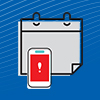Blog
3 ways to optimize your hospital’s directory and on-call schedules to reach providers faster
Keys to data and on-call optimization
As the main communication hub for many hospitals, the contact center can be an incredibly powerful part of healthcare organizations. Individual departments often look to the contact center as the source of truth. In addition to letting callers know about parking options and cafeteria hours, contact center agents often launch critical codes and facilitate clinical staff communications. They’re tasked with ensuring the right people get the right message on the right device at the right time. And that means meticulous upkeep of various staff directories and on-call calendars.
In this post, we offer tips to help you and your organization maintain a robust healthcare communication solution, which is especially critical during this time of COVID-19. Below are three key considerations for establishing accurate, relevant data across your organization. This will be the foundation of any effective communication technology effort. Good communication enables various care team members to reach providers more quickly around the clock, ultimately improving patient care.
1. Create teams to ensure data relevancy
Step one is to create a cross-functional user group and continually engage with these valuable resources to understand their business needs and communication challenges. You will also be able to discover what data is relevant and meaningful. What your contact center agents need might not be the same as what the emergency department staff needs. To determine who and how to communicate with the right people, periodically touch base with the user group to validate that the data is relevant and meaningful and meets their workflow requirements.
2. Align on naming conventions
Another critical step is to validate your on-call, directory, and department naming conventions. This is critical. We often hear, for example, that HR keeps track of all people and staff information, but their department naming convention doesn’t make sense to the rest of the organization. You want to make sure that teams across the hospital or health system align so anyone in your organization can find the right on-call group or person at the right time.
Your goal is to make your communication solution your organization’s Google or Zoom for clinical communication. And a solid directory is key. But how do you get disparate departments to align?
The secret is to focus on “What’s in it for me?” Rather than announcing yet another system that users need to maintain, always emphasize the benefits. Something as simple as aligning on what your department should be called throughout the organization might mean that a physician can make or receive a consult call more easily, eliminating the need to either send multiple messages or wait 20 minutes to an hour to be able to get a call-back.
Make sure your end users know there really is a purpose for your processes, and that it’s going to improve their workflow, simplify their day, and support patient care.
3. Continual review
Finally, put governance in place to determine how frequently you’re going to update your on-call directory. You need to establish business rules to confirm directory and on-call records are added and deleted efficiently.
Bring your cross-functional team together at least twice a year to review data relevancy. Have departments changed? Have you added a new wing or unit? Regular, periodic review will ensure your data remains relevant.
Also think about educating staff. Do you have new residents and fellows every year? Onboarding new employees is a great time to offer refresher education to existing staff or ask them to review their contact information. Adding governance around periodic data review is important to maintaining good data and ensure you have a successful solution.
Helping staff connect
Implementing a successful communication solution isn’t a “one and done” proposition. Now that you understand the importance of accurate data to successful healthcare communication, you’re one step closer to helping nurses and other care team members reach physicians faster. Having easily accessible—and accurate—directory and contact information is a critical component of staff efficiency and top-notch patient care.
Learn how VHC Health increased operator productivity
by eliminating paper-based on-call- scheduled







